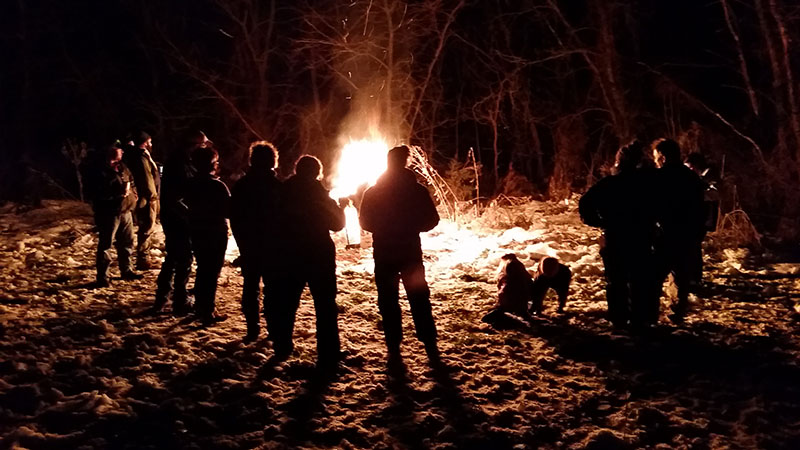
Every winter my family takes part in a cherished holiday tradition–we burn a piano.
Dec 23, 2015–On a recent trip to Iowa I took part in our family’s cherished holiday tradition–we burned a piano.
That’s right. On a cold Midwestern night, with snow on the ground and stars overhead, family and friends circled the instrument and took turns playing it even as flames licked up the sides. When the fire leaped from between the keys, we backed off and watched another spinet decompose into carbon, oxygen, hydrogen, and an 800-degree soundboard. [See 1:00 Video]
There’s something mystical about putting fire to a piano. But that’s not what this column is about.
Last time I wrote about this, some readers got very upset that we would desecrate such a sacred instrument. So this trip I sought out someone who could explain why burning an old piano is the best outcome for science, music, and a dozen inebriated Iowans.
I went directly to the source of our piano habit. Matt McClellen (who let me use his real name) is a piano technician. For 15 years he has tuned good pianos, refurbished damaged pianos, and disposed of hundreds of bad pianos. And he has given this a lot of thought.
McClellen once calculated that 750 piano makers turn out 300,000 new pianos every year in the U.S. The Pierce Piano Atlas estimates that over the 300 years pianos have existed, tens of millions have been manufactured. Bottom line, that’s a lot of pianos going moldy in drawing rooms.
 And there was a vast range of quality.
And there was a vast range of quality.
“The majority were mass produced, not made by hand,” McClellen said. “Some were very cheap, and these were built before air conditioning, so they saw extreme variance in humidity and temperature. That’s what ages them.”
Those deficiencies are not always evident.
“A piano may look perfect on the outside, but when you open it up, it looks like a haunted house inside,” he said. “Many were not maintained. Imagine keeping a car that you didn’t drive or maintain. They really have no value. There are just so many of them, they are usually free if you haul them away.”
So what happens?
Part of McClellen’s job with a music store was to dispose of unfixable pianos. Even in a small city this came to more than 100 pianos every year. Imagine having to get rid of a pile of pianos that size. It wasn’t pretty.
“The movers used to take them out and smash them up, so they could pull what metal they could and take it to the scrap yard,” he said. “It was hard to get the metal out, very labor intense.”
And the result was hardly worth it. The cast iron in a piano amounted to $3 to $4 per piano. The copper had some value, but it would take an hour to separate it from the steel, and someone had to know what they were doing.
One day while they were hacking at pianos, one of the movers had a revelation.
“He said, I’ve got a farm. Let’s just take them out and burn them.” So they did. “We found it was easier to put 15 pianos in a pile, burn them, take the scrap metal out, then haul what was left to the landfill.”
A tradition was born.
Back to that mystical part. For Matt McClellen, the event has a Zen quality.
“It’s like punching the boss in the face,” he said.
Whoa. He walked it back a bit. “Yes, I enjoy it, and yes, I respect a good instrument. But there are so many bad ones. When you work on this piano because someone hired you, and you have to fix it, you can try your hardest to make it work and sometimes it just doesn’t work. Imagine the frustration you can take out by burning it. For me, it’s vindication. That’s why I first did it.”
Yet the same people who have no problem cremating grandpa are horrified to incinerate a piece of furniture. McClellen understands.
“If I’m going to destroy a piano and the client is real sensitive about grandma’s piano, I don’t bring it up,” he said. “But mostly I am brutally honest about what we do and why. I’ll even show pictures. They get kick out of that.”
Some artsy types tried helping old pianos cross the rainbow bridge by using them for art installations. They took old pianos and set them on the street for people to paint and play on. This didn’t work.
“The problem is that pianos must avoid two things: fire and water,” McClellen said. “Once they get wet, they are worse than a barroom piano. When a piano is rained on, it becomes a brick.”
But a piano burns very nicely (something to consider if you have one in the middle of your living room).
“They are really dry wood coated with lacquer, so they will go up like a bomb,” said McClellen, who starts them with a small kindling by the pedals. “The wood can burn to 800 degrees, hot enough to melt the lead and aluminum, and make the cast iron brittle.”
So don’t cry for that keyboard. Think of it as playing a hot tune for its final encore.